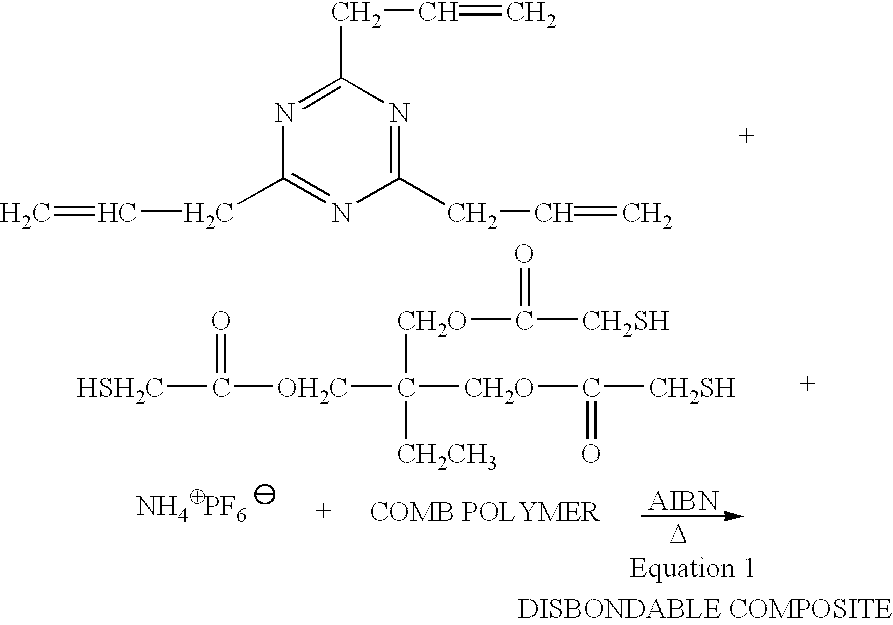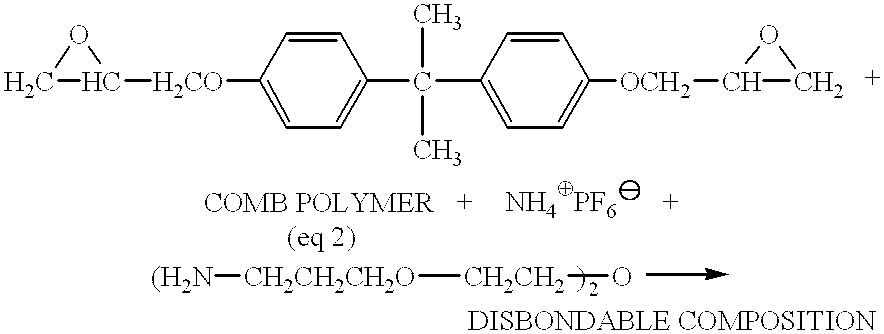Electrically disbonding materials
- Summary
- Abstract
- Description
- Claims
- Application Information
AI Technical Summary
Benefits of technology
Problems solved by technology
Method used
Image
Examples
example 1
This example describes an electrochemically disbondable composition using a plasticizer as the ionically conductive component.
A disulfide-linked diepoxide 1 of the following structure was synthesized according to the procedures outlined by Gilbert et al in Mater. Res. Soc. Proc., Polymer / Inorganic Interfaces, 304:49 (1993). ##STR2##
An electrocleavable formulation was made by mixing 100 parts by weight of the above diepoxide with 30 parts of 4,7,10-trioxi-1,13-tridecanediamine and 10 parts of amine-terminated poly(acrylonitrile-co-butadiene), a rubber toughener (CAS 68683-29-4). To this mixture was added 20 parts each of 1-pentanol and ammonium hexafluorophosphate. The mixture reacted rapidly at room temperature to yield a cured resin which exhibited very high adhesive bond strengths to copper. This composition relied upon a combination of a plasticizer and chemical modification of the epoxy, e.g., incorporation of alkoxy-modified amine curing agent and acrylonitrile copolymer and al...
example 2
This example describes an electrochemically disbondable composition using an ion exchanged graft copolymer, poly[dimethylsiloxane-co-methyl(3-hydroxypropyl)siloxane]-graft-poly(ethyl ene glycol) 3-aminopropyl ether, as the ionically conductive component.
In a reaction vessel equipped with a mechanical stirrer, poly[dimethylsiloxane-co-methyl(3-hydroxypropyl)siloxane]-graft-poly(ethyl ene glycol) 3-aminopropyl ether (PDMS-graft-PEG) (75 g), an amine-functionalized comb polymer (CAS 133779-15-4) with a M.sub.n of ca. 4000 was mixed with ammonium hexafluorophosphate (25 g, 0.153 mol) and the mixture was stirred at 70.degree. C. for 12 hours under vacuum to allow the ion exchange reaction to proceed to completion. The resulting product was a viscous, transparent amber liquid.
A two-part epoxy resin was formulated using the above ion-exchanged PDMS-graft-PEG. Part A was formulated by blending 100 parts by weight ion-exchanged PDMS-graft-PEG with 75 parts by weight of a low molecular weight...
example 3
This example demonstrates the effect of substitution of the amine curing agent on the strength and disbanding function of an epoxy composition.
An epoxy resin was prepared as described in Example 2, with substitution of 4,7,10-trioxa-1,13-tridecanediamine with 15 parts tetraethylene pentamine (TEPA; CAS No. 112-57-2) to yield an electrocleavable composition having bond strengths of up to 2500 psi to aluminum at both ambient and elevated temperatures. The disbonding conditions and rates were similar to those in Example 2. Disbonding occurred at the anode.
PUM
| Property | Measurement | Unit |
|---|---|---|
| Pressure | aaaaa | aaaaa |
| Shear strength | aaaaa | aaaaa |
| Shear strength | aaaaa | aaaaa |
Abstract
Description
Claims
Application Information
 Login to View More
Login to View More - Generate Ideas
- Intellectual Property
- Life Sciences
- Materials
- Tech Scout
- Unparalleled Data Quality
- Higher Quality Content
- 60% Fewer Hallucinations
Browse by: Latest US Patents, China's latest patents, Technical Efficacy Thesaurus, Application Domain, Technology Topic, Popular Technical Reports.
© 2025 PatSnap. All rights reserved.Legal|Privacy policy|Modern Slavery Act Transparency Statement|Sitemap|About US| Contact US: help@patsnap.com



